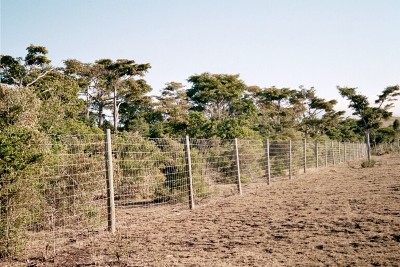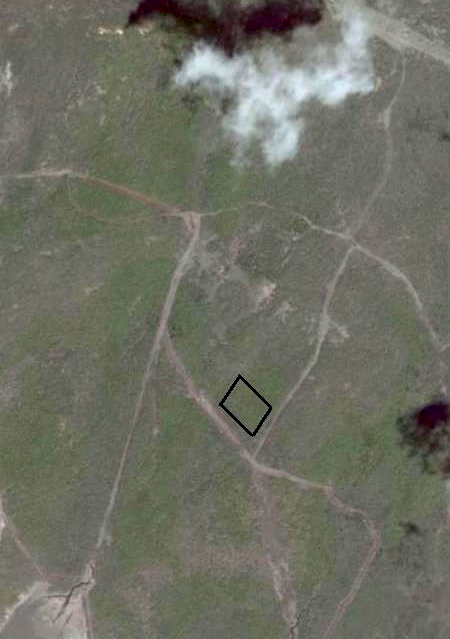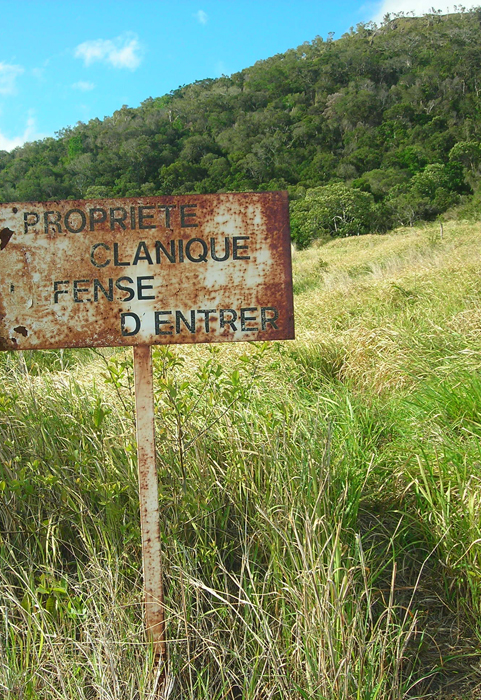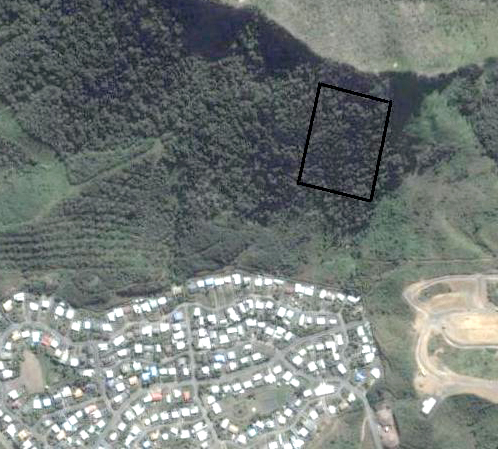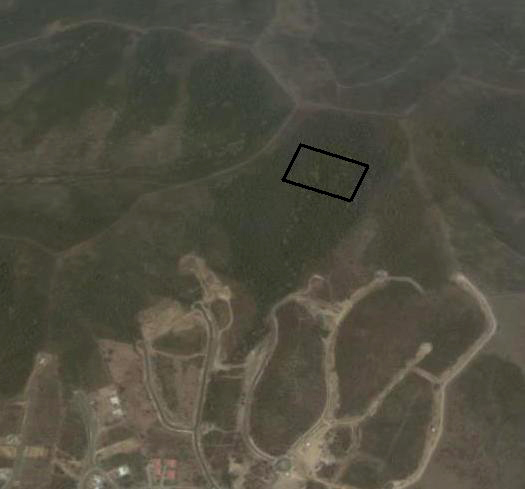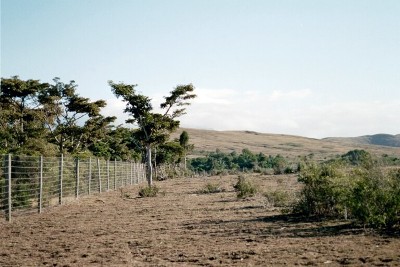 Tropical dry forest in New Caledonia is one of the world’s most endangered tropical dry forest based on the current extent of the forest, endemism, number of protected areas, and threatened species (Gillespie & Jaffré 2003). Currently, the nature reserve system in New Caledonia is not adequate to protect tropical dry forest species (Jaffré et al. 1998). Management of fire, non-native plants and animals, and reintroduction of rare native species on private and community lands is of utmost importance. Forest regeneration experiments like the one that occurred in tropical dry forests in Guanacaste, Costa Rica and those undertaken by conservation institutions in New Caledonia with the participation of World Wildlife Fund will be necessary to protect remaining relics of tropical dry forest and increase their forest cover.
Tropical dry forest in New Caledonia is one of the world’s most endangered tropical dry forest based on the current extent of the forest, endemism, number of protected areas, and threatened species (Gillespie & Jaffré 2003). Currently, the nature reserve system in New Caledonia is not adequate to protect tropical dry forest species (Jaffré et al. 1998). Management of fire, non-native plants and animals, and reintroduction of rare native species on private and community lands is of utmost importance. Forest regeneration experiments like the one that occurred in tropical dry forests in Guanacaste, Costa Rica and those undertaken by conservation institutions in New Caledonia with the participation of World Wildlife Fund will be necessary to protect remaining relics of tropical dry forest and increase their forest cover.

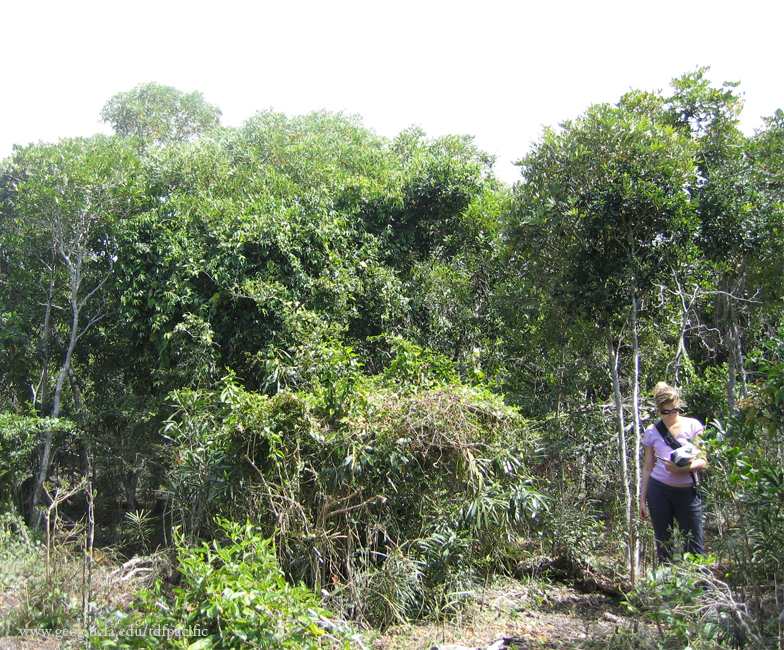
THE RESEARCH
New Caledonia is located in the southwest Pacific about 1,200 km east of Queensland, Australia. New Caledonia has been identified as a biodiversity hotspot with 3261 native plant species, 74% of which are endemic (Myers et al. 2000; Jaffré et al. 2001). Melanesias, known as Kanaks in New Caledonia, colonized New Caledonia 3,500 year ago. The Kanaks are famous for their diversity of thatch huts that are adorned by a fleche or arrow to honor ancestral spirits. New Caledonia was discovered by Captian Cook in 1774. He named it after old Caledonia or Scotland because many sections of the island looked like the Moors of Scotland. Today, New Caledonia is a French territory like French Polynesia.
New Caledonia is an ancient landmass that broke off Australia 85 million years ago and saved ancient plants from
that time period which have gone extinct elsewhere. The terrestrial vegetation of New Caledonia can be divided into three major native vegetation types: maquis scrub, rain forest, and tropical dry forest (Jaffré et al. 1998). Tropical dry forest is the most endangered of these vegetation types because it has been reduced to less than 2% of its original extent in New Caledonia due to land clearance, cattle ranching, and fire (Bouchet et al. 1995). The tropical dry forest in New Caledonia contains 407 woody species, 243 of which are endemic to New Caledonia and 60 are endemic and restricted to tropical dry forest.
Study Sites:
(Refer to map for Study Site links.)
This This research was conducted at six tropical dry forest sites in western island of Grand Terre: Ouen-Toro, Pindai, Nekoro, Metzdorf, Propriete Clanique, Savanna.
Location: METZDORF
Metzdorf is an extremely small fenced fragment that has been protected on private land. The surrounding area has no native tree species due to fire and heavy grazing by cattle and goats. However, the small fragment contains over 25 native species including the endangered trees Captaincookia margaretae and Terminalia cherrieri.
Location: PINDAI
Pindai is a headland located on the central coast of New Caledonia that is managed by the Northern Province Forest Service in order to prevent fire. Pindai site is composed of Miocene limestone covered by lateritic immigrants. A 2 ha relic of a once more extensive tropical dry forest persists in an area protected from fire. Tropical dry forests are surrounded by gaïac shrub vegetation that is dominated by Acacia spirorbis which is considered dry forest and accounts for a majority of dry forest cover. However, this small fragment contains incredible high levels of diversity (53 woody species), 28 of which are endemic to New Caledonia, and six that are on the IUCN Threatened Species List.
Location: NEKORO
Nekoro is a reserve of private land that contains large expanses of Acacia spirorbis and native dry forest species. The forest has a short 5 meter canopy and was significantly impacted by a recent tropical storm. There were over 26 native species in the area including the dry forest endemic Captaincookia margaretae.
Location: OUEN-TORO
Ouen-Toro is a 44 ha provincial park at the southern limits of the capital city, Noumea. The Ouen Toro site is composed of Eocene sandstone and mudstone. Ouen-Toro was a military base during World War II with trails crossing the entire park. Wild fires have been limited since the war and a fire suppression program has been in place for the last 30 years. This permitted the regeneration of small patches of tropical dry forest, the largest of which is less than 1 ha. The tropical dry forests are surrounded by gaïac shrub vegetation that is dominated by Acacia spirorbis.
Location: PROPRIETE CLANIQUE
Clanque is located on a steep west facing slope. The fragment is protected from fire by steep slopes and low litter build up, however, it is surrounded by high grasslands and the edges of the fragment has been significantly effected by periodic fires. This area contains moderate levels of native species richness. There is also a great deal of regeneration in the understory most likely do to recent fire suppression programs.
Location: SAVANNAH
Savannah is located behind a recent housing development. This relatively large fragment has been protected and due to the proximity with the new housing development there is little evidence of recent fire. The forest has a high canopy of 7 to 10 meters and is the most species richness site in southern New Caledonia. However, the site contains a number of tree species that also occur in moist forest sites in New Caledonia.
There might not have been any remaining fragments of tropical dry forest in New Caledonia if it was not for Tanquy Jaffré from Laboratoire de Botanique et d’Ecologie Végétale Appliquées, IRD. He has dedicated a large part of his life to protecting dry forest and educating the people of New Caledonia about its uniqueness. The impact of this one individual can not be overstated and some of the most important dry forest conservation areas are largely due to his conservation efforts. Parc Forestier Michel Corbasson has small fragments of tropical dry forest, but the site is located within a zoological park with cement trails and aviaries within the forest fragments. The tropical dry forest in Lepredour, that contained the only populations of Pittosporum tanianum and Leptostylis sp., has recently been destroyed by fire (Bouchet et al. 1995). Similar natural or anthropogenic caused fires could destroy remaining tropical dry forests at all sites. Remaining fragments of tropical dry forest are restricted to private or community land where fire has now been limited, but cattle and introduced deer are common. Two important relics of dry forests are located on private lands. Tiéa near Pouembout contains a fragment of tropical dry forest that covers 32 ha and another fragment near the community of Poya contains a fragment of tropical dry forest of 15 ha. A recent cooperative agreement among private landowners at these sites and institutions in New Caledonia and the World Wildlife Fund has resulted in the protection of these fragments. In particular, fences have been erected to prevent the intrusion of cattle and deer; and rehabilitation of the forest by the mechanical removal of exotics is underway.
Bouchet P.H., Jaffré T. and Veillon, J. M. 1995. Plant extinction in New Caledonia: protection of sclerophyll forests urgently needed. Biodiversity and Conservation 4: 415-428.
Gillespie, T.W. and Jaffré, T. 2003. Tropical dry forests of New Caledonia. Biodiversity and Conservation 12: 1687-1697.
Jaffré T., Bouchet P. and Veillon, J.M. 1998. Threatened plants of New Caledonia: Is the system of protected areas adequate? Biodiversity and Conservation 7: 109-135.
Jaffré T., Morat P., Veillon J., Rigault F., and Dagostoni, G. 2001. Composition and characterisation of the native flora of New Caledonia. Centre IRD, Documents Scientifiques et Techniques, II4, 1-121.
Myers N., Mittermeier, R.A., Mittermeier C.G., da Fonseca, G.A. and Kent J. 2000. Biodiversity hotspots for conservation priorities. Nature 403: 853-858.
Acknowledgments
There would have been much less forest to study if it was not for the tireless work of Tanquy Jaffré. We thank Christophe Lambert for permission to work in New Caledonia and a tour of Parc Forestier. We thank Emile Audet for his tireless effort to establish Ouen-Toro as a park and Gilles Dagostini and Jerome Muntzinger for help with plant identification. Christine Farris, Victoria Michelle, and Danielle Ellis collected field data under difficult conditions. Chelsea Robinson helped with remote sensing research.
Thank you to Google Earth for providing the plot images.
